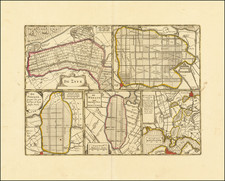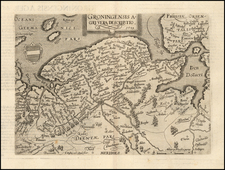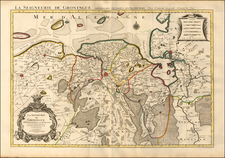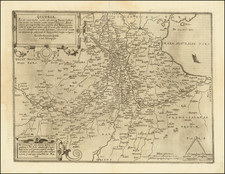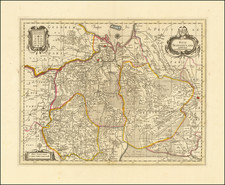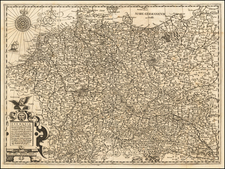Amsterdam -- The Sun and Soul of the Entire World
An important early view of Amsterdam, celebrating the city's ascent to the trading capital of the World at beginning of the 17th Century.
Taken from the River IJ, the view shows Amsterdam as a bustling center of World trade, in a marvelous blend of topographical realism and allegorical splendor, symbolizing the prosperity and broad worldly reach of the city.
The view bears the names Harmanus Allardi Coster and Nicolaus Johannis Visscher (Claes Janszoon Visscher). Coster is Hermann Allartz Coster (1572 to 1652), a printer and publisher, also known as Allard, who added "Coster" to his name in 1603, after he became sexton of the Nieuwe Kerk in Amsterdam.
Visscher's view is engraved utilzing an earlier 2-sheet view of Amsterdam by Pieter Bast (died circa 1605), Bast's Gezicht op Amsterdam, vanuit het IJ Amstelredam of 1599, view, taken from a similar position looking across the River IJ. As described by Anat Gamboa in Symbolic Landscapes:
Visscher actually started out with two copper plates that were engraved . . . by Pieter Bast. Later on, Visscher reprocessed the plates, using the old vista and adding newer Amsterdam buildings.
"In its amplitude and the sheer audacity of the presentation, this engraving is indisputably one of Bast's most significant creations. It is as much a portrait of the harbour of Amsterdam as of the city itself and underscores the unique importance of maritime trade as the principle source of the city's wealth and power". With its distinctive orientation [Bast] not only initiated the series of representations of Amsterdam as seen from the IJ, but also "established the standard for an entire genre of Dutch maritime painting" (Keyes).
To the original 2 Bast plates, Visscher would add to additional plates, nearly doubling the width of the view, In the sky, Visscher replaced the simple utilitarian title and simple coats of arms, with a more embellished allegorical coat of arms of Amsterdam in the center, flanked by two coat of arms held aloft by angels with trumpets, and two elaborate allegorical title cartouches. Along the bottom is a remarkable scene, built around the Maid of Amsterdam.
The Maid of Amsterdam Recieving Gifts
At the bottom center of the view is an image of the Maid of Amsterdam, perched upon a stage supported by wooden piles, in the same manner as the construction of the city. At her feet is arrayed a group of secular and sacred objects. The image presents an elaborate allegorical scene of the Maid receiving gifts from representatives of all parts of Europe and known the World; represented by a collection of traders, farmers, and merchants, each with distnctive goods and wares of their region, gathered on the city's waterfront, prepared to approach the Maid with their offerings.
Among the more fascinating elements is the inclusion to her left of exotic peoples and animals, symbolizing the diverse trading relationships already fostered by the city by the beginning of the 17th Century. For example, at the bottom right there are images of camels, reindeer and perhaps a monkey or two, along with costumed traders from various parts of Africa, the Middle East and East Indies.
The text accompanying the Rijksmuseum copy of the map describes Amsterdam as the new Athens, "the sun and soul not only of Europe, and parts of Africa . . but of the entire World" . . . "the light-shining and heart-warming gleam of her evident lust, spreads itself so powerfully across the entire earh."
Rarity
We locate two surviving examples illustrated on line:
- Rijksmuseum: https://www.rijksmuseum.nl/en/collection/RP-P-AO-20-22
- Metropolitan Museum of Art: https://www.metmuseum.org/art/collection/search/653171
In the catalog entry describing the example sold to the Metropolitan Museum of Art, the dealer suggests that there are 9 surviving examples.









